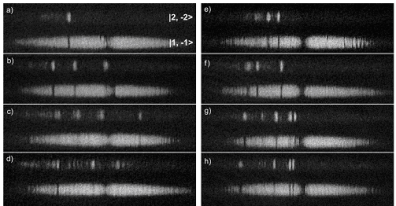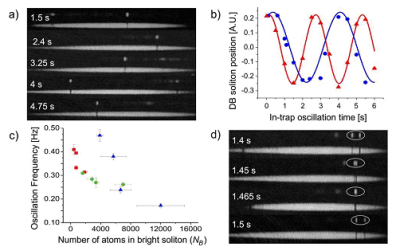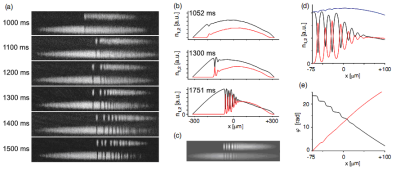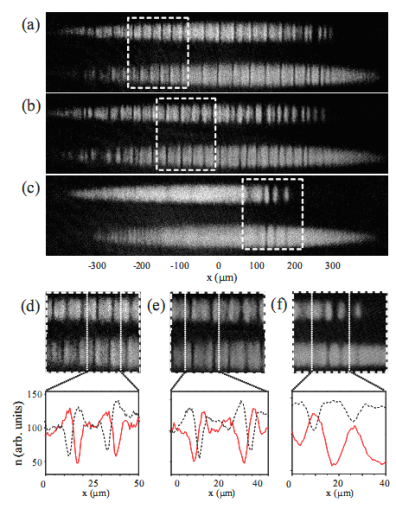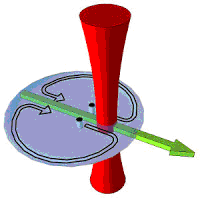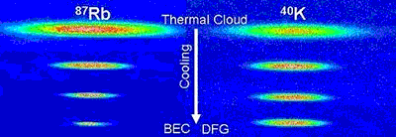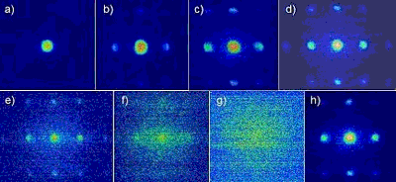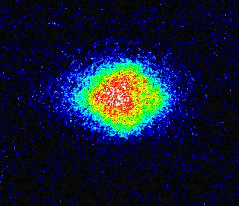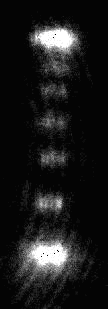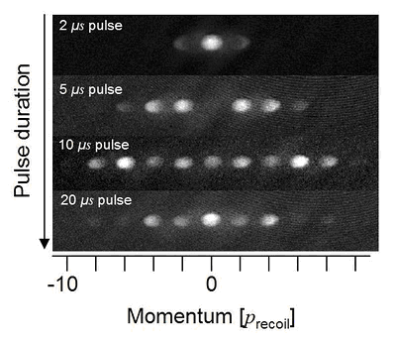Ground-based Research at WSU
B-lab
B-lab houses the first BEC apparatus in the pacific northwest (PNW). It was started in 2004 after Dr. Engels arrived at WSU with the first BECs made in 2006. Since that time, the apparatus has been improved and added on to for better stability, systematic control, and more variety in experiments. This apparatus continues to be the main workhorse for research in our group and is capable of producing Rb-87 BECs (bosons) and K-40 DFGs (fermions) in both optical and magnetic traps. B-lab is where the majority of projects to date have been completed.

E-lab
E-lab houses the second cold atom apparatus at WSU. First conceptualized around 2010, this apparatus is designed to be a multiple isotope system housing Rb-87 (boson), K-41 (boson), K-39 (boson), and Li-6 (fermion). The first BEC for in the E-lab was made at the end of 2015 using an optical trap. These BECs are extremely elongated, with aspect ratios of approximately 100:1. The focus of experiments in this lab are probing quantum hydrodynamics along a channel in the nonlinear regime.

Research Focuses
Spin-Orbit Coupling (SOC) [1]
Hydrodynamics [1]
Dicke-type phase transitions [1]
Collective excitations [1]
Supersolids [1]
Soliton formation/dynamics
Dark-Bright solitons [1, 2, 3, 4]
Dark-Antidark solitons [1]
3-component solitons (dark-dark-bright, dark-bright-bright) [1]
Quantum Hydrodynamics
Excitation dynamics
Dispersive & Viscous Shock Waves [1, 2, 3]
Optical Lattices
Past Project Descriptions
Negative mass hydrodynamics in a spin-orbit-coupled Bose-Einstein condensate
Negative mass can be realized in quantum systems by engineering the dispersion relation. A powerful method is provided by spin-orbit coupling, which is currently at the center of intense research efforts. Here we measure an expanding spin-orbit coupled Bose-Einstein condensate whose dispersion features a region of negative mass. We observe a range of dynamical phenomena, including the breaking of parity and of Galilean covariance, dynamical instabilities, and self-trapping. The experimental findings are reproduced by a single-band Gross-Pitaevskii simulation, demonstrating that the emerging features — shockwaves, soliton trains, self-trapping, etc. — originate from a modified dispersion. Our work also sheds new light on related phenomena in optical lattices, where the underlying periodic structure often complicates their interpretation.
PRL publication here (arXiv version here) chosen as a PRL Editor’s Choice piece. To see an in depth discussion of this topic, please see our collaborator, Michael Forbes, website.
Vector Dark-Antidark Solitary Waves in Multi-Component Bose-Einstein condensates
Multicomponent Bose-Einstein condensates exhibit an intriguing variety of nonlinear structures. In recent theoretical work [C. Qu, L. P. Pitaevskii, and S. Stringari, Phys. Rev. Lett. 116, 160402 (2016)], the notion of magnetic solitons has been introduced. Here we examine a variant of this concept in the form of vector dark-antidark solitary waves in multicomponent Bose-Einstein condensates (BECs). We first provide concrete experimental evidence for such states in an atomic BEC and subsequently illustrate the broader concept of these states, which are based on the interplay between miscibility and intercomponent repulsion. Armed with this more general conceptual framework, we expand the notion of such states to higher dimensions presenting the possibility of both vortex-antidark states and ring-antidark-ring (dark soliton) states. We perform numerical continuation studies, investigate the existence of these states, and examine their stability using the method of Bogoliubov–de Gennes analysis. Dark-antidark and vortex-antidark states are found to be stable for broad parametric regimes. In the case of ring dark solitons, where the single-component ring state is known to be unstable, the vector entity appears to bear a progressively more and more stabilizing role as the intercomponent coupling is increased.
PRA article here.
Spin-momentum coupled Bose-Einstein condensates with lattice band pseudospins
The quantum emulation of spin-momentum coupling (SMC), a crucial ingredient for the emergence of topological phases, is currently drawing considerable interest. In previous quantum gas experiments, typically two atomic hyperfine states were chosen as pseudospins. Here, we report the observation of a new kind of SMC achieved by loading a Bose-Einstein condensate (BEC) into periodically driven optical lattices. The s- and p-bands of a static lattice, which act as pseudospins, are coupled through an additional moving lattice which induces a momentum dependent coupling between the two pseudospins, resulting in s-p hybrid Floquet-Bloch bands. We investigate the band structures by measuring the quasimomentum of the BEC for different velocities and strengths of the moving lattice and compare our measurements to theoretical predictions. The realization of SMC with lattice bands as pseudospins paves the way for engineering novel quantum matter using hybrid orbital bands.
arXiv version here
Nature Communications publication found here
Measurement of collective excitations in a spin-orbit-coupled Bose Einstein condensate
We measure the collective excitation spectrum of a spin-orbit coupled Bose-Einstein condensate using Bragg spectroscopy. The spin-orbit coupling is generated by Raman dressing of atomic hyperfine states. When the Raman detuning is reduced, mode softening at a finite momentum is revealed, which provides insight towards a supersolid-like phase transition. We find that for the parameters of our system, this softening stops at a finite excitation gap and is symmetric under a sign change of the Raman detuning. Finally, using a moving barrier that is swept through the BEC, we also show the effect of the collective excitation on the fluid dynamics.
Phys Rev A 90, 063624
arXiv version here
Spin-orbit coupled Bose-Einstein condensates in a one-dimensional optical lattice
The realization of artificial gauge fields and spin-orbit coupling for ultra-cold quantum gases promises new insight into paradigm solid state systems. Here we experimentally probe the dispersion relation of a spin-orbit coupled Bose-Einstein condensate loaded into a translating optical lattice by observing its dynamical stability, and develop an effective band structure that provides a theoretical understanding of the locations of the band edges. This system presents exciting new opportunities for engineering condensed-matter analogs using the flexible toolbox of ultra-cold quantum gases.
Phys. Rev. Lett. 114, 070401
arXiv version here
Dicke-type phase transition in a spin-orbit coupled Bose-Einstein condensate
Spin-orbit coupled Bose-Einstein condensates (BECs) provide a powerful tool to investigate interesting gauge-field related phenomena. We study the ground state properties of such a system and show that it can be mapped to the well-known Dicke model in quantum optics, which describes the interactions between an ensemble of atoms and an optical field. A central prediction of the Dicke model is a quantum phase transition between a superradiant phase and a normal phase. Here we detect this transition in a spin-orbit coupled BEC by measuring various physical quantities across the phase transition. These quantities include the spin polarization, the relative occupation of the nearly degenerate single particle states, the quantity analogous to the photon field occupation, and the period of a collective oscillation (quadrupole mode). The applicability of the Dicke model to spin-orbit coupled BECs may lead to interesting applications in quantum optics and quantum information science.
Nature Communications 5, doi:10.1038/ncomms5023,
arXiv version here
Experimental Observation of Moving Magnetic Orders and Dark-bright Solitons
We experimentally investigate the phase winding dynamics of a harmonically trapped two-component BEC subject to microwave induced Rabi oscillations between two pseudospin components. While the single particle dynamics can be explained by mapping the system to a two-component Bose-Hubbard model, nonlinearities due to the interatomic repulsion lead to new effects observed in the experiments: In the presence of a linear magnetic field gradient, a qualitatively stable moving magnetic order that is similar to antiferromagnetic order is observed after critical winding is achieved. We also demonstrate how the phase winding can be used as a new tool to generate copious dark-bright solitons in a two-component BEC, opening the door for new experimental studies of these nonlinear features.
arXiv version here.
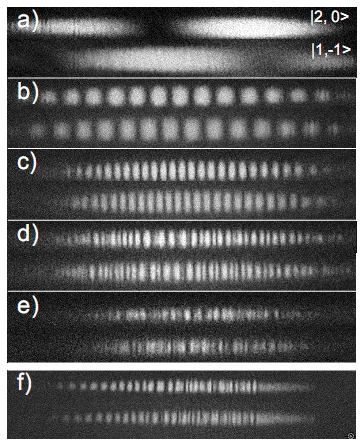
Observation of Zitterbewegung in a spin-orbit coupled Bose-Einstein condensate
Spin-orbit coupled ultra-cold atoms provide an intriguing new avenue for the study of rich spin dynamics in superfluids. In this Letter, we observe Zitterbewegung, the simultaneous velocity (thus position) and spin oscillations, of neutral atoms between two spin-orbit coupled bands in a Bose-Einstein condensate (BEC) through sudden quantum quenches of the Hamiltonian. The observed Zitterbewegung oscillations are perfect on a short time scale but gradually damp out on a long time scale, followed by sudden and strong heating of the BEC. As an application, we also demonstrate how Zitterbewegung oscillations can be exploited to populate the upper spin-orbit band, and observe a subsequent dipole motion. Our experimental results are corroborated by a theoretical and numerical analysis and showcase the great flexibility that ultra-cold atoms provide for investigating rich spin dynamics in superfluids.
Phys. Rev. A 88,021604 (2013) ,
arXiv version here.
Scattering of atomic dark–bright solitons from narrow impurities
In this work, we examine the collision of an atomic dark–bright soliton, in a two-component Bose–Einstein condensate, with a Gaussian barrier or well. Our study has both an experimental component and a theoretical/computational one. First, we present the results of an experiment, illustrating the classical particle phenomenology (transmission or reflection) in the case of an equal barrier in both components. Then, motivated by the experimental observations, we perform systematic simulations considering not only the case of equal heights of a barrier (or a well), but also the considerably more complex setting, where the potential affects only one of the two components. We systematically classify the ensuing cases within a two-parameter diagram of potential amplitudes in the two components, and provide intuitive explanations for the resulting observations, as well as of their variations as the strength of the potential changes.
J.Phys. B: At. Mol. Opt. Phys. 46, 065302 (2013),
arXiv version here.
Beating dark-dark solitons in Bose-Einstein condensates
Motivated by recent experimental results, we study beating dark-dark solitons as a prototypical coherent structure that emerges in two-component Bose-Einstein condensates. We showcase their connection to dark-bright solitons via SO(2) rotation, and infer from it both their intrinsic beating frequency and their frequency of oscillation inside a parabolic trap. We identify them as exact periodic orbits in the Manakov limit of equal inter-and intra-species nonlinearity strengths with and without the trap and showcase the persistence of such states upon weak deviations from this limit. We also consider large deviations from the Manakov limit illustrating that this breathing state may be broken apart into dark-antidark soliton states. Finally, we consider the dynamics and interactions of two beating dark-dark solitons in the absence and in the presence of the trap, inferring their typically repulsive interaction.
J. Phys. B: At. Mol. Opt. Phys., 45 115301 (2012)
Dynamics of Dark-Bright Solitons in Cigar-Shaped Bose-Einstein Condensates
We explore the stability and dynamics of dark-bright solitons in two-component elongated Bose-Einstein condensates by developing effective 1D vector equations as well as solving the corresponding 3D Gross-Pitaevskii equations. A strong dependence of the oscillation frequency and of the stability of the dark-bright (DB) soliton on the atom number of its components is found. Spontaneous symmetry breaking leads to oscillatory dynamics in the transverse degrees of freedom for a large occupation of the component supporting the dark soliton. Moreover, the interactions of two DB solitons are investigated with special emphasis on the importance of their relative phases. Experimental results showcasing dark-bright soliton dynamics and collisions in a BEC consisting of two hyperfine states of 87Rb confined in an elongated optical dipole trap are presented.
Phys. Lett. A 375 (2011) 642-646
Dark-bright soliton generation by counterflow
Our manuscript “Generation of Dark-Bright Solitons Trains in Superfluid-Superfluid Counterflow” has been published in PRL. It is available through this link: Phys.Rev. Lett.106, 065302 (2011). Please note that this manuscript replaces arXiv:1005.2610.
Dark-dark solitons and modulational instability in miscible two-component Bose-Einstein condensates
We investigate the dynamics of two miscible superfluids experiencing fast counterflow in a narrow channel. The superfluids are formed by two distinguishable components of a trapped dilute-gas Bose-Einstein condensate (BEC). The onset of counterflow-induced modulational instability throughout the cloud is observed and shown to lead to the proliferation of dark-dark vector solitons. These solitons, which we observe for the first time in a BEC, do not exist in single-component systems, exhibit intriguing beating dynamics and can experience a transverse instability leading to vortex line structures. Experimental results and multi-dimensional numerical simulations are presented.
Phys. Rev. A 84, 041605 (2011), arXiv version here.
Viewpoint Article
Viewpoint article on “Observation of Vortex Dipoles in an Oblate Bose-Einstein Condensate” by T. W. Neely et al. (Phys. Rev. Lett. 104, 160401 (2010)) now available at the following link: Observing the dance of a vortex-antivortex pair, step by step.
Older News – Jan 09 to May 09
May 2009 – Degenerate Fermi Gas
We have a Degenerate Fermi Gas!!!
Using sympathetic cooling of 40K with 87Rb, we have created a quantum degenerate Bose-Fermi mixture. We are able to reach a temperature of about T/Tf=0.2 for the Fermi cloud. A sequence of images taken towards the end of the sympathetic cooling process is shown below.
April 2009 – Mott Insulator
We have successfully transitioned from a superfluid state to the Mott insulator state and back again to superfluidity in our 3D optical lattice. In the absorption images below, matter wave interference patterns were observed after releasing 87Rb atoms from a lattice potential depth of a) 0 E-recoil, b) 5 E-recoil, c) 10 E-recoil, d) 15 E-recoil, e) 20 E-recoil, f) 22 E-recoil, and g) 24 E-recoil. In h), we recover superfluidity after ramping the lattice back down from 24 E-recoil in 15 ms.
March 2009 – 2D Kapitza-Dirac Scattering
With the successful alignment of our two horizontal 1064nm optical lattice beams, we have realized 2D Kapitza-Dirac scattering and have measured the band population of a dephased BEC showing the filling of the First Bruillion zone of the optical lattice. This was demonstrated at ~ 8 E-recoil.
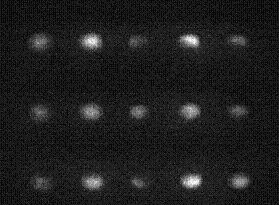
2D Kapitza-Dirac Scattering of a single condensate.
We have finished the setup of our 3D 1064 nm optical lattice and have seen interference patterns of a BEC released out of a 3D lattice. We are now minimizing heating in the optical lattice to demonstrate a Mott Insulator state.

While aligning the vertical lattice beam we took the opportunity to view some Bloch Oscillations as seen below.
In continuing our research of ultracold gases we have recently realized our 40K MOT and are investigating the technique of sympathetic cooling via 87Rb to form ultracold Fermi gases.
January 2009 – 1D Optical Dipole Trap and 1D Lattice
With the addition of our high power 1064nm fibre laser we have created a 1D optical dipole trap to further the study of solition formation. This trap increases the aspect ratio of our traping frequences by a factor of about 4 and allows us to better observe the solition formation characteristics.
With the successful implementation of our 1064nm optical dipole trap we have been able to implement a 1D optical lattice. Below is an image of Kapitza-Dirac scattering realized in the 1D lattice.
Formation of Quantum Shock Waves by Merging and Splitting Bose-Einstein Condensates
The processes of merging and splitting dilute-gas Bose-Einstein condensates are studied in the nonadiabatic, high-density regime. Rich dynamics are found. Depending on the experimental parameters, uniform soliton trains containing more than ten solitons or the formation of a high-density bulge as well as quantum (or dispersive) shock waves are observed experimentally within merged BECs. Our numerical simulations indicate the formation of many vortex rings. In the case of splitting a BEC, the transition from sound-wave formation to dispersive shock-wave formation is studied by use of increasingly stronger splitting barriers. These experiments realize prototypical dispersive shock situations.
Phys. Rev. Lett. 101, 170404 (2008)
See also M. A. Hoefer, P. Engels, and J.J. Chang, Matter Wave Interference in Bose-Einstein Condensates: a Dispersive Hydrodynamic Perspective, Physica D 238, 1311 (2009).
Piston Dispersive Shock Wave Problem
The piston shock problem is a classical result of shock wave
theory. In this work, the analogous dispersive shock wave (DSW) problem for a
fluid described by the nonlinear Schrödinger equation is analyzed. Asymptotic
solutions are calculated for a piston (step potential) moving with uniform
speed into a dispersive fluid at rest. In contrast to the classical case, there
is a bifurcation of shock behavior where, for large enough piston velocities,
the DSW develops a periodic wave train in its wake with vacuum points and a
maximum density that remains fixed as the piston velocity is increased further.
These results have application to Bose-Einstein condensates and nonlinear
optics.
Phys. Rev. Lett. 100, 084504 (2008)
Stationary and Nonstationary Fluid Flow of a Bose-Einstein Condensate Through a Penetrable Barrier
We experimentally study the fluid flow induced by a broad, penetrable barrier moving through an elongated dilute gaseous Bose-Einstein condensate. The barrier is created by a laser beam swept through the condensate, and the resulting dipole potential can be either attractive or repulsive. We examine both cases and find regimes of stable and unstable fluid flow: At slow speeds of the barrier, the fluid flow is steady due to the superfluidity of the condensate. At intermediate speeds, we observe an unsteady regime in which the condensate gets filled with dark solitons. At faster speeds, soliton formation completely ceases, and a remarkable absence of excitation in the condensate is seen again.

